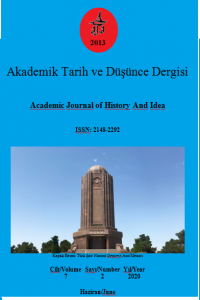Eskiçağda Doğu-Batı Mücadelesine Kısa Bir Bakış
Doğu ve Batı dünyaları ilk kez Troya Savaşları’nda karşı karşıya gelmişlerdir. Homeros’un İlyada adlı destanından öğrenildiğine göre on yıl süren bu savaş, Batı dünyasını temsil eden Akalar’ın galibiyeti ile neticelenmiştir. Arkeolojik bulgulardan anlaşıldığı kadarıyla bu ilk büyük mücadele, MÖ.1240-1230 yılları arasına tarihlenmektedir. Son araştırmalar göstermiştir ki, savaşlara sahne olan Troya kenti, Troya’nın VII-a tabakasıdır. Çünkü bu tabakada, şehrin Akalar tarafından yakıldığına işaret eden kalın bir kül katmanına rastlanmıştır.Doğu-Batı çatışmasının ikinci raundu, Pers-Yunan Savaşları’dır. Bu mücadelede Batı dünyasını Yunan şehir devletleri, Doğu dünyasını ise Persler temsil etmekteydi. MÖ. 490-479 yılları arasında cereyan eden bu savaş hakkındaki en ayrıntılı bilgileri, büyük tarihçi Herodotos vermektedir. Bu mücadelenin galibi de Batı dünyası olmuştur. Eskiçağ tarihinde Doğu ile Batı arasındaki üçüncü büyük mücadele, Makedonyalı Büyük İskender ile Pers İmparatorluğu arasında yaşanmıştır. Büyük İskender, 13 yıl süren kısa saltanatına rağmen, Ege kıyılarından Hindistan’daki İndus vadisine kadar uzanan bütün Pers topraklarını ele geçirmiş ve Pers İmparatorluğu’nu ortadan kaldırmıştır. Daha sonraki süreçte, Doğu ve Batı dünyaları arasındaki mücadele, dinler savaşı biçiminde devam etmiştir. Bunun en çarpıcı örneğini Haçlı Seferleri teşkil eder.
Anahtar Kelimeler:
Eski Doğu- Batı, Troya Savaşları, Pers-Yunan Savaşları, Büyük İskender., Eski Doğu- Batı, Troya Savaşları, Pers-Yunan Savaşları, Büyük İskender.
A Brief Overview of The East-West Struggle in Antiquity
The Eastern and Western Worlds confronted for the first time in the Trojan Wars. According to what is learned from Homer’s epic called Iliad, this war, which lasted for ten years, resulted with the victory of the Achaeans representing the Western World. As understood from the archaeological findings, this first great struggle is dated between 1240-1230 BC. Recent researches have shown that the city of Troy, which was the scene of wars, is the VII-a layer of Troy. Because in this layer, a thick layer of ash was encountered, indicating that the city was burned by the Achaeans. The second round of the East-West conflict is the Persian-Greek Wars. In this struggle, the Greek city-states the Western World and the Persians represented the Eastern World. Herodotos provides the most detailed information about this war that took place between 490-479 BC. The winner of this struggle was the Western World.The third great struggle between East and West in ancient history was experienced between Alexander the Great of Macedon and the Persian Empire. Alexander the Great conquared all the Persian lands from the Aegean Sea coast to the Indus Valley in India, despite his short reign, which lasted 13 years, and destroyed the Persian Empire. In the following period, the struggle between the Eastern and the Western worlds continued in the form of a war of religions. The most striking example of this is the Crusades.
Keywords:
Ancient East- West, Trojan Wars, The Persian-Greek Wars, Alexander the Great, Ancient East- West, Trojan Wars, The Persian-Greek Wars, Alexander the Great,
___
- BARNET, R. D., “The Sea Peoples”, Cambridge Ancient History II/2, chp. XXVIII, Cambridge, 1975, s.359-371.
- BENGTSON, H., The Greeks and the Persians, Delacorte Press, New York 1968.
- BLEGEN, C., Troy and the Trojans, Antiquity Publications Ltd., London 1963.
- Yayın Aralığı: Yılda 6 Sayı
- Başlangıç: 2013
- Yayıncı: Hakan YILMAZ
Sayıdaki Diğer Makaleler
Tebriz’in Mimari Sembolü: Gök Mescit
Nurullah BÜLBÜL, Mine AKKAYNAK
XIX. Yüzyılda Piyano ve Osmanlı Kadını
İrade MƏMMƏDOVA, Elnur NƏCİYEV
Gelibolu Gazisi John Masefield'in Savaş Çabaları
Eskiçağda Doğu-Batı Mücadelesine Kısa Bir Bakış
Geçmişten günümüze işitme engellilerin eğitimi ve Türk işaret dilinin rolü
Eski Asur Şehir Meclisi’nin Memurları
Türk Edebiyatında Mevlânâ, Mesnevî ve Mevlevîlik Hakkında Farsça Yazılan Eserler
